

Grow Free Sharing Carts. Bg gen reducingfireriskingardens. Oz Lithops Home. Science of Gardening - Faculty of Science, Engineering & Technology. Science of Gardening is for everyone, from avid green-thumbs with a lifetime of experience to those planting their first seedling.

You’ll learn fundamental sciences behind a range of traditional and modern gardening techniques, which will answer why plants do what they do, and what you can do to grow and shape your garden like never before. Important and interesting questions for gardeners include why are plants arranged into families, and what features do they share? The Cactus and Succulent Society of NSW Inc. Browse Succulents by Origin. Lana and Bruce’s Coastal Country Garden. Lana and Bruce Moran took two years to find their perfect property, one “where the country meets the sea”, as they describe it.

“We love Yalambie, and don’t ever want to move again.” When Lana and Bruce Moran moved to their 8ha property on Victoria’s Mornington Peninsula five years ago, there was much work to be done. Since then, they have replanted, refined and extended the garden to cover more than 3ha, a process that is still continuing. A successful design device is the use of mounding, created with flowing contours to define areas, add interest and set up favourable growing conditions for plants that need good drainage. Also distinctive is the use of undulating rivers of clipped natives such as coastal rosemary and waxflower. In a garden without town water, sustainability is important. Native plants dominate, but some areas are dedicated to flowers or produce. In a sheltered courtyard near the house, raised vegetable beds provide flourishing produce on demand. The Art and Science of Making a Hugelkultur Bed - Transforming Woody Debris into a Garden Resource. Used for centuries in Eastern Europe and Germany, hugelkultur (in German hugelkultur translates roughly as “mound culture”) is a gardening and farming technique whereby woody debris (fallen branches and/or logs) are used as a resource.
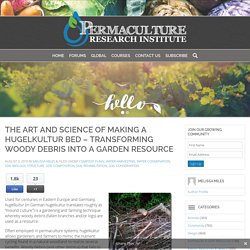
Often employed in permaculture systems, hugelkultur allows gardeners and farmers to mimic the nutrient cycling found in a natural woodland to realize several benefits. Woody debris (and other detritus) that falls to the forest floor can readily become sponge like, soaking up rainfall and releasing it slowly into the surrounding soil, thus making this moisture available to nearby plants. Hugelkultur: The Composting Raised Beds. By Dan Hughes Hügelkultur, translated literally from german, means ‘mound culture.’
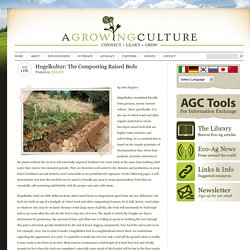
Trench Composting Your Kitchen Waste. The Vermicomposting Trench. I’ve been looking forward to writing this post for quite some time now.

As I mentioned in the post about my restaurant vermicomposting project, the trench idea started as somewhat desperate attempt to deal with the large quantities of food waste I’ve been receiving each week. Since that time, it has become much more than that – I like to think of it as a long-term, slow-release, natural fertilizer factory (or LTSRNFF for short – haha).
I situated my first trench directly in front of my tomato bed, thinking that it might help them grow somewhat better. How to Root Roses from Cuttings. I have tried just about every method out there to propagate roses from cuttings.
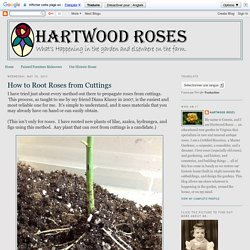
This process, as taught to me by my friend Diana Klassy in 2007, is the easiest and most reliable one for me. It's simple to understand, and it uses materials that you may already have on hand or can easily obtain. (This isn't only for roses. I have rooted new plants of lilac, azalea, hydrangea, and figs using this method. Any plant that can root from cuttings is a candidate.) How to Propagate Basil. Propagating Succulents — Needles + Leaves. Now we wait.
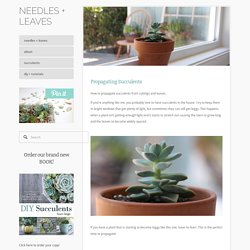
Before we can place our leaves on soil to begin growing new plants we must let the ends dry out and callous over. Sketch restaurant filled with floral installations for Flower Show. Four leading florists have created installations that transform areas of London restaurant Sketch into blooming gardens or woodland glades, to coincide with this week's Chelsea Flower Show (+ slideshow).

The Mayfair restaurant invited the florists to develop bold installations that showcase their skills at the event, which Sketch has labelled the Mayfair Flower Show in reference to the famous horticultural show taking place concurrently in Chelsea. Each installation celebrates the British countryside, so only plants found in the UK were used, including birch, roses, foxgloves and lily of the valley.
13 DIY Garden Fountains That Are Easy For Doing - Top Inspirations. If you want to decorate your garden but also not to spend money, we have a lot of ideas for you.
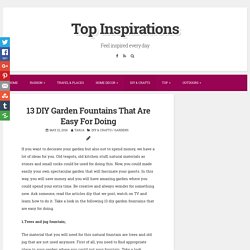
Old teapots, old kitchen stuff, natural materials as stones and small rocks could be used for doing this. Now, you could made easily your own spectacular garden that will fascinate your guests. In this way, you will save money and you will have amazing garden where you could spend your extra time. 10+ Greenhouses Made From Old Windows and Doors. Here’s a great idea.
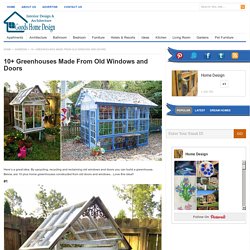
By upcycling, recycling and reclaiming old windows and doors you can build a greenhouse. Below, are 10 plus home greenhouses constructed from old doors and windows…Love this idea!! #2 Blue “greenhouse” made from old windows source #4 Old window greenhouse source #5 Greenhouse from old windows. Grow a Vegetable Garden in Raised Beds. Benefit: Save Your Back with a Raised Garden Bed Raised-bed vegetable gardening can reduce back strain because you won’t have to bend over as far to reach the plants. With easier access and less pain potential, you're better able to enjoy the labor involved in planting, tending, and harvesting your raised vegetable garden. Raised garden bed tip: Build your raised garden beds so they're at least 12 inches tall. If the walls are slightly below waist level, you can sit on edges to work the soil and harvest your bounty without having to bend over at all.
See our easy, step-by-step instructions for making a raised bed. Sue and Brian's Park-Style Country Garden. Having lived at their two hectare property in Wamberal on the NSW Central Coast for 35 years, Sue and Brian Mann preferred to rebuild rather than move when it came time to upgrade their home. "Our brief was simple," says Sue. "We wanted a timeless house that would suit our extended family. Our children and grandkids live a stone's throw away and are here every weekend. " The resort-style feel of their new house deserved a garden to complement it so Sue turned to noted landscape designer Michael Cooke, an expert in acreage properties. Most rooms in the new house look out to the garden, so the interaction between inside and out was critical. 10 Of The Best Gardens From Australian House & Garden. Begonia Propagation Page.
Propagationby Brad Thompson This page will describe the various ways to propagate begonias through cuttings. Starting begonias from seed is covered in another chapter so won’t be addressed here. Rooting cuttings to form new plants is basically a type of cloning. How to Water Succulents. Rather than giving your succulents sips of water here and there, give them a good soaking -- to the point the water runs out the drainage holes at the bottom of the pot. Be sure to empty the water that runs into the saucer beneath the plant pot. Then let the soil dry out completely before watering again. Horticulturist Bryce Lane with North Carolina State University recommends checking the soil a week after watering; if it's still moist, wait another week.
Sedums, sempervivum (commonly called hens-and-chicks), jade plants, kalanchoe, aloe vera, and sansevieria (also known as snake plant or mother-in-law's tongue) are popular choices for indoor plants. Succulents also include cacti, which, generally, may need less water than other succulents. Succulents like well-drained soil. Succulents require more water in the early spring when the plant is growing. The frequency of watering will also depend on the light and growing conditions in your area, as well as the size of the container.
Gallery - Sue and Brian's Park-Style Country Garden. Wildwood Garden Blue Mountains. Wildwood is set amid tall trees on a north-facing sloping site. It enjoys a cool climate and has deep, fertile soil. And, although there’s abundant rain, a lake and a bore ensure the garden never wants for water.